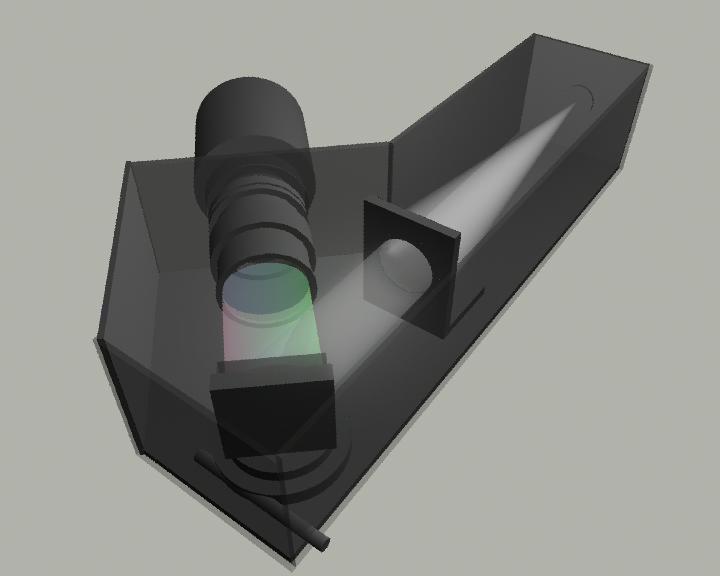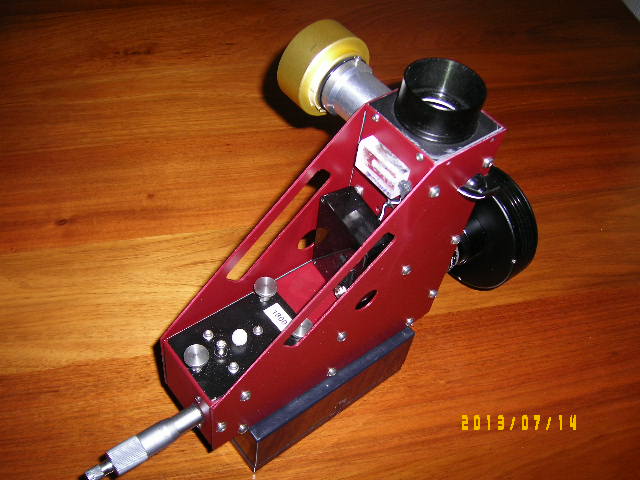Other Spectroscope Designs


Other spectrograph designs
There are many variations on the basic Littrow and Classical designs. Spherical mirrors can be used in place of the achromat lens as collimators. Transmission gratings can also be incorporated into slit spectrograph designs. Another important spectrograph is the echelle design.
Other DIY designs
Transmission gratings
The Watkis compact slit transmission grating spectrograph is an interesting DIY project.
The TRAGOS design from the CAOS team includes a grsim to improve performance
Buil's LORIS design allows for the deviation angle of the grating used.
In the VdS Newsletter Spektrum51 Uwe Zurmuhl describes his grism arrangement.
Fulvio Mete has built a grism low res spectrograph using many standard components.Spec 600 The rotary reflective multi slit plate from Jeulin is used as well as a 600 L/mm grism removed from a Hawksley D-V spectroscope. Resolution around R=800.
Reflection gratings
We have various DIY spectroscope designs available - MG80 - This is a compact 300 l/mm faint object instrument built around a Vixen flip mirror body, an 80mm focal length collimator and standard 50mm camera lens, using various T thread adaptors/ spacers..
There's also the FC120 - a Folded Classical design based on a 120mm achromat collimator, various gratings (from 150 to 1200 l/mm) and a choice of an achromat imaging lens or better still a Canon 85mm f1.8 photographic lens. This basic folded design is very similar to the design chosen by Paul Gerlach for his 3D printed LowRes instrument.
CLAUS Fulvio Mete's Cylindrical Lens design
COGOS Fulvio Mete's Concave grating design
The reflective collimator mirror design of the Thompson spectrograph (S&T Feb74) designed by Daniel Schroeder for the Thompson Observatory at Beliot College is very reminiscent of the Optomechanics 10C design (detailed in Astronomical Spectroscopy for Amateurs, p84).
Using the spherical mirror as the collimator reduces the chromatic effects of the usual achromat.
The current LowSpec 3D printed, folded Classical, by Paul Gerlach is proving popular. His 3D files are available here. There are many currenly being made.
Echelle design basics
A coarse (low l/mm) reflection grating is used behind a collimator. The entrance slit is usually replaced by a fibre optic connection, either 50 or 100 micron diameter.
The dispersed beam from the echelle grating contains many over lapped spectra (see spectral orders,free spectral range) and needs a further disperser (prism/ grating) to separate the various orders. This then presents the total spectra in a large array usually requiring a large camera format to record them all. The benefit of the echelle is in achieving a high R value (up to R=10000) across the whole visible spectral range with no moving parts in the system.
Klaus Vollmann's SimEchelle spreadsheet (right click, "download as") allows evaluation of echelle designs
Star Echelle Here Fulvio Mete shows an ingenious simple echelle design
Christian Buil has an interesting page on the echelle.
The processing of the multiple echelle orders, and the provision of suitable extended reference line data also demands attention.
Beamsplitters, slit and fibre guiders
As previously mentioned many DIY spectroscope builds fail to appreciate the importance of being able to use the spectroscope effectively on the telescope. This comes down to incorporating a good acquisition and guiding arrangement. 99% of all serious spectrographs make use of reflective slit plates to allow focusing and guiding the target star image onto the entrance slit gap.
The reflective slit plate is slightly inclined (around 15 degrees) to the optical axis, parallel with the height of the slit gap, a small mirror and transfer lens (around 30mm fl) are used to image the slit gap in the guider. This arrangement can be seen in the drawings of the DADOS, TRAGOS and the LhiresIII instruments.
A workable alternative is to position a beamsplitter prior to the entrance slit and "divert" some of the incoming light to the guider.
A "virtual" slit can be provided by software like Al's reticule. This allows acquisition of the target and positioning on the slit gap.
Modifying a Vixen flip mirror body to a beamsplitter guider is detailed here
For Echelle specroscopes it is normal to use a optical fibre in lieu of a slit. 50 and 100 micron fibres being widely used. Using these fibres raises the problems of acquisition and guiding. Positioning a target star image on such a small aperture makes further demands on the guider arrangement. The construction of the echelle "guide head" can be complex. In Tonkin's "Practical Astronomical Spectroscopy" there's a desciption of modifying a syringe needle (!) as a guider....
The CAOS guys have detailed their ideas: using fibres and outline some guide options - fibre guiders
An interesting paper is here. This uses an array of six fibres and a split mirror guider (See Sect 3.6)
When all else fails you can always use the Shelyak fibre guider head, used on their eShel.